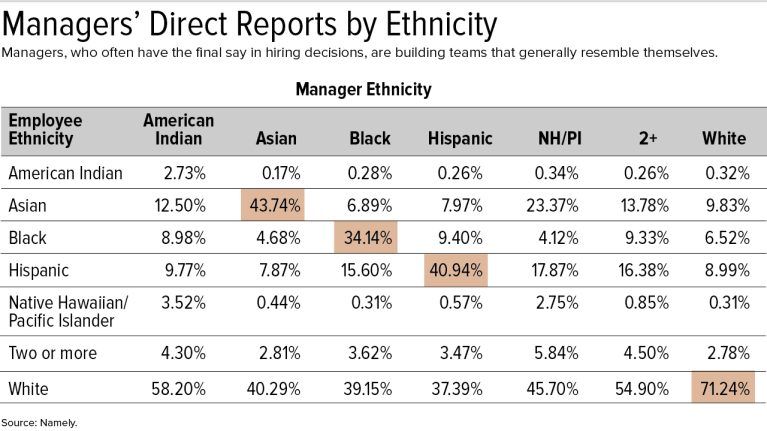Direct reports often reflect their manager's ethnicity when those managers have the final say in hiring decisions, a recent 2018 workplace diversity report found.
For example, nearly 44 percent of employees with an Asian manager are Asian, according to Namely, an HR, payroll and benefits platform based in New York City. And while white employees account for the majority of direct reports in most instances, they rank second on teams led by Asian and Hispanic managers. This lack of diversity is not limited to ethnicity: Nearly 80 percent of male employees report to men and more than 50 percent of women report to women. The least common reporting structure is for a male employee to report to a female manager.
"While we're seeing greater diversity holistically, we still have a long way to go to get past 'similar as me' and unconscious bias," said Debra Squyres, Namely's chief people officer, during a Society for Human Resource Management #Nextchat discussion on Twitter.
Namely's findings were collected in May from more than 1,000 of its clients that have more than 175,000 employees globally.
"Our data," Squyres tweeted, "shows that there is still not diversity at the team level in midsize companies."
The report suggests that women and nonwhite managers "are uniquely positioned to serve as change agents" and help companies find other talented, diverse workers.
Ensuring Diversity at Small Companies
Everyone at Trussworks, a software infrastructure consulting company based in San Francisco, is expected to play a role in creating diverse teams—particularly in recruiting, hiring and various company initiatives, according to CEO Everett Harper, who is black.
In 2011, Harper co-founded the company with Jennifer Leech, who is white and vice president of engineering, and Mark Ferlatte, who is white and chief technology officer. Managers' specific responsibilities include recruiting diverse candidates and "listening [to] and ensuring multiple perspectives are being represented when making both small and large decisions," Harper said.
Among the company's 31 employees, 38 percent are women. Women make up 44 percent of the engineers and 25 percent of the managers at the company. Additionally, 21 percent of the employees are people of color—black, Latino, Asian, Harper said.
Diversity was intentional from the beginning, he said.
"We welcomed a woman co-founder. You can't underestimate how that makes a big difference" by bringing a perspective that likely wouldn't exist otherwise.
One of the strategies Trussworks uses to build diversity is participating in coding events for women and minorities. The company also asks the participants for their reactions to its recruiting materials.
"Being open to that feedback before you start recruiting enables you to establish processes that reflect the interests and priorities and needs of the [demographics] you're recruiting," Harper said.
Volunteering, hosting or judging hackathons on issues important to under-represented minorities has been a great diversity tactic, the company has found.
"We helped judge a breast pump hackathon at MIT," Harper said, citing one initiative. "The key here is to go beyond sponsorship. Potential candidates notice if a company sends just a public relations/marketing representative versus a knowledgeable and relevant domain expert who works side-by-side with the teams. The latter is much more attractive to a potential candidate, and the company will learn a lot about the candidate and the issues they care about."
[SHRM members-only how-to guide: How to Develop a Diversity and Inclusion Initiative]

Most of the people applying for a job at BlueprintNYC, Manhattan engagement experts, are white. That's reflective of the public relations industry in the U.S.; white workers hold more than three-fourths of PR jobs and two-thirds of advertising jobs, according to Namely. That means BlueprintNYC, which employs 40 people, must be proactive in finding diverse candidates.
It does that through a grassroots approach, according to co-founders and managing partners DJ Hanson and John Sideris, who describe themselves as white, gay, middle-aged men.
"We started to look at where we post our jobs and which schools were posting our jobs, which diversity groups," Hanson said. Among its employees, 56 percent are women, 40 percent are nonwhite and 30 percent are LGBT.
"We do have a very deliberate [career] path at Blueprint. We expose them to everything and have a conversation within a few months [about] what's resonating. Is it production? Business management? The creative arts/director side? And then we can put them on a path."
A former freelance employee who had a background in fashion, for example, now is an executive producer at Blueprint.
Sideris said the company is interested in finding employees who also bring a diversity of thought and experience. That's an example of looking for culture add rather than culture fit.
Culture add refers to the unique experiences, values, skills and personality traits that a candidate brings to the workplace to make it more diverse, explained Paige Charbonneau, SHRM-CP. She oversees recruiting strategies as HR manager at Aqueduct Technologies in Waltham, Mass.
"Creativity in thinking and problem-solving … stems from a diverse set of backgrounds, perspectives and experiences from which you can pull," she said. "I try to encourage our interview collaborators to look beyond the words within the applicant's answers and focus on the insight/thought process of why the applicant responded in a certain way."
She also recommended organizations not limit their search to people who hold titles similar to the positions they are trying to fill.
"Instead, determine the underlying traits and skills that would lead to success … and try to find those in other industries or positions. That may help you diversify your applicant pool and find qualified talent in new, creative places."
Was this resource helpful?





